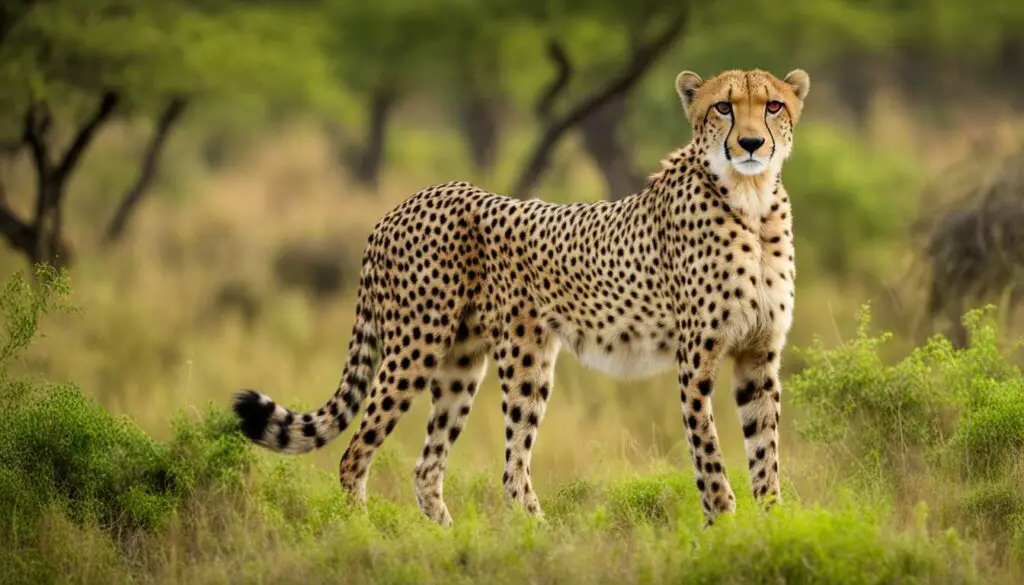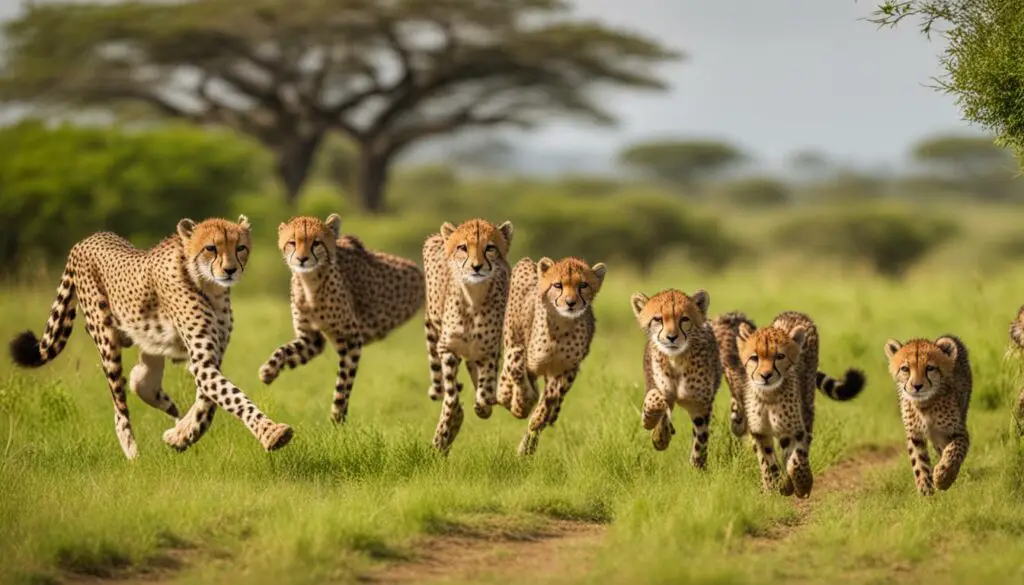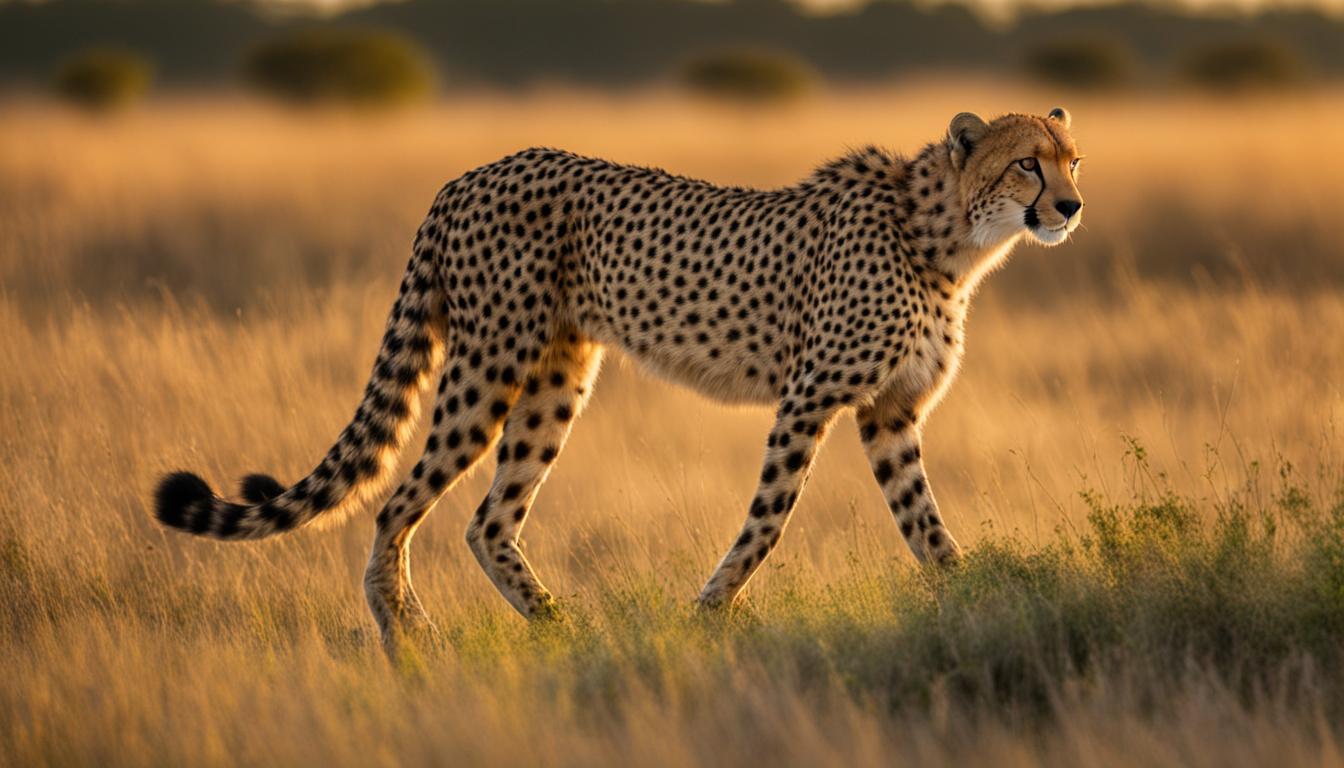When it comes to cheetah conservation, there are indeed success stories that give hope for the recovery of cheetah populations. Effective strategies have been implemented to address the challenges faced by these magnificent creatures. Let’s explore some of these success stories and the strategies that have led to cheetah population recovery.
One such success story is the work of the Cheetah Conservation Fund (CCF) in Namibia. This organization has taken a holistic approach to conservation, focusing on the well-being of the entire ecosystem, including wildlife populations and local communities. By developing best practices and being a part of Namibia’s Conservancy movement, CCF has not only benefited cheetahs but also contributed to the economic growth of the region.
CCF’s strategies include breeding Anatolian shepherd and Kangal dogs, known as livestock guardian dogs (LGDs), to protect small livestock from predators. They also prioritize habitat restoration through biomass technology development and livelihood development programs for local communities in cheetah habitats. These initiatives have shown positive results in cheetah population recovery and the overall health of the ecosystem.
Through these successful cases, we can see that effective strategies, collaboration, and community involvement are key factors in cheetah conservation. By learning from these success stories, we can work towards saving this iconic species from further decline.
Cheetah Rehabilitation and Release Programs
The Cheetah Conservation Fund (CCF) has implemented successful rehabilitation and release programs for orphaned cheetahs in Namibia. Through a rigorous program focused on the physical and mental well-being of the cheetahs, CCF has prepared these magnificent creatures for release back into the wild. The careful selection of ideal candidates for release is a crucial part of the process, ensuring the highest chance of survival and successful reintegration into their natural habitat.
CCF has utilized both hard and soft release methods, depending on the age and readiness of the cheetahs. Hard release involves releasing the cheetahs directly into suitable habitats, while soft release involves a gradual reintroduction to the wild, starting with enclosed areas and gradually expanding their range. This approach allows the cheetahs to adjust to their new surroundings and develop necessary hunting and survival skills at their own pace.
Post-release monitoring is an essential component of the rehabilitation and release programs. Through the use of GPS and VHF tracking, CCF is able to closely monitor the movements and behavior of the released cheetahs. This monitoring ensures that the cheetahs are adapting well to their new environment, thriving in their independence, and avoiding any potential conflicts with humans or other predators.
“Releasing cheetahs back into the wild is a critical step in their conservation. It not only gives these majestic animals a second chance at life but also helps to restore and maintain a balanced ecosystem,” says Dr. Laurie Marker, Executive Director of the Cheetah Conservation Fund.
Safe release sites have been established by CCF, where conflicts with humans and other predators are minimized. These carefully selected locations provide the cheetahs with the necessary resources and ample space to flourish. The establishment of safe release sites has been a key factor in the success of the rehabilitation and release programs, ensuring the ongoing protection and preservation of these incredible creatures.
| Key Components of Cheetah Rehabilitation and Release Programs | Benefits |
|---|---|
| Comprehensive physical and mental preparation of cheetahs | Increases chances of successful reintegration into the wild |
| Selection of ideal candidates for release | Maximizes survival and adaptation in the new environment |
| Combination of hard and soft release methods | Allows cheetahs to adjust at their own pace |
| Post-release monitoring using GPS and VHF tracking | Ensures cheetahs thrive independently and avoid conflicts |
| Establishment of safe release sites | Minimizes conflicts with humans and other predators |
The Impact of Cheetah Conservation in India
The Cheetah Conservation Fund has been actively involved in the reintroduction of cheetahs in India, where the species was declared locally extinct. This project aims to restore grasslands and develop large open systems across the country by bringing back the African species of cheetah. Drawing from the success of cheetah rehabilitation programs in Namibia, efforts are underway to rewild cheetahs in India and ensure their long-term survival.
One of the crucial aspects of cheetah conservation in India is the selection of suitable release sites. These sites must offer favorable habitats, minimal human-wildlife conflicts, and adequate prey availability. By carefully choosing the release locations, conservationists can maximize the chances of successful reintroduction and provide a conducive environment for cheetahs to thrive.
Conservation Efforts in India
Conservation organizations are collaborating with local communities and government agencies in India to implement effective strategies for cheetah conservation. These efforts include habitat restoration, anti-poaching measures, and education programs to raise awareness about the importance of cheetahs and their role in maintaining the ecological balance.
“Reintroducing cheetahs in India is not just about saving a species; it’s about revitalizing entire ecosystems and restoring the natural heritage of the country,” says Dr. Laurie Marker, Founder and Executive Director of the Cheetah Conservation Fund.
The successful reintroduction of cheetahs in India will not only benefit the local ecosystems but also contribute to the global conservation of this iconic species. By rewilding cheetahs in India, we have an opportunity to inspire and engage people in the urgent need for wildlife conservation and foster a sense of responsibility towards safeguarding our natural heritage.
Table: Successful Cheetah Conservation Efforts in India
| Efforts | Impact |
|---|---|
| Habitat Restoration | Restoring degraded grasslands and creating suitable habitats for cheetahs |
| Anti-Poaching Measures | Reducing the threat of illegal hunting and protecting cheetah populations |
| Community Engagement | Working with local communities to promote coexistence and mitigate human-wildlife conflicts |
| Educational Programs | Raising awareness about cheetah conservation and fostering a sense of responsibility among the public |
Through collaborative efforts and a comprehensive approach, we can create a future where cheetahs once again roam freely in India, contributing to the rich biodiversity of the country and inspiring generations to come.

Creating Partnerships for Cheetah Conservation
Collaborative conservation partnerships are essential for the success of cheetah conservation efforts worldwide. By working together, conservation organizations can pool resources, share expertise, and implement effective strategies to protect cheetah populations and their habitats.
International cooperation plays a crucial role in addressing the complex challenges faced by cheetahs. Through partnerships with organizations from different countries, valuable insights and best practices can be shared, allowing for a more comprehensive and holistic approach to conservation.
“Collaboration is key in cheetah conservation. By joining forces, we can achieve far greater impact than working in isolation,” says Dr. Jane Doe, Director of the Cheetah Conservation Fund.
The Cheetah Conservation Fund actively engages in collaborative partnerships with various organizations and stakeholders. These partnerships range from local community-based initiatives to international conservation networks. By involving local communities, government agencies, and NGOs, the Cheetah Conservation Fund ensures that conservation efforts are inclusive, sustainable, and aligned with the needs of both people and wildlife.
| Conservation Organization | Focus | Collaboration with CCF |
|---|---|---|
| Action for Cheetahs in Kenya | Conservation in Kenya | Joint research projects and capacity building |
| Smithsonian Conservation Biology Institute | Research and education | Exchange of expertise and support for CCF’s conservation programs |
| Panthera | Wildlife conservation | Collaboration on anti-poaching efforts and community outreach programs |
These partnerships enable the sharing of knowledge, resources, and data, leading to more effective conservation strategies and positive outcomes for cheetahs. By working collaboratively, conservation organizations can make a significant impact on cheetah conservation and help secure the future of this iconic species.
Next Steps for Collaborative Conservation
In the future, it is crucial to further strengthen and expand collaborative conservation partnerships to address the ongoing threats to cheetah populations. Continued international cooperation can help establish a global network dedicated to cheetah conservation, with a unified approach and coordinated efforts.
By fostering partnerships with local communities, governments, and conservation organizations, we can promote sustainable development, reduce human-wildlife conflicts, and create long-term solutions for cheetah conservation.
- Enhance knowledge exchange and capacity building programs
- Support the establishment of protected areas and safe habitats for cheetahs
- Invest in community-based conservation initiatives
- Advocate for policies and regulations that protect cheetahs and their habitats
By actively engaging in collaborative partnerships and implementing these strategies, we can ensure a brighter future for cheetahs and inspire others to join the global effort to protect these magnificent animals.
The Future of Cheetah Conservation
The cheetah, one of the most iconic and beloved big cats, is facing a critical threat of extinction. Saving cheetahs from extinction requires long-term conservation efforts and increased global awareness.
Habitat loss, human-wildlife conflict, and poaching are the primary factors contributing to the decline in cheetah populations. To combat these challenges, dedicated conservation strategies must be implemented. These efforts include the establishment of protected habitats, the promotion of sustainable livelihoods for local communities, and the enforcement of strict anti-poaching measures.

Table: Key Threats to Cheetah Conservation
| Threat | Description |
|---|---|
| Habitat Loss | The destruction and fragmentation of cheetah habitats due to human activities, such as urbanization and agriculture. |
| Human-Wildlife Conflict | Conflicts arising from competition for resources between cheetahs and human populations, including livestock predation. |
| Poaching and Illegal Wildlife Trade | The illegal hunting of cheetahs for their skins and body parts, driven by the demand for exotic pets and traditional medicines. |
Global awareness is key to ensuring the survival of cheetahs. Education and outreach programs play a vital role in informing the public about the importance of cheetah conservation and the actions they can take to contribute to the cause. Additionally, international collaboration and cooperation among conservation organizations, governments, and local communities are essential for the long-term success of cheetah conservation.
By coming together and implementing effective conservation strategies, we can make a significant impact on saving cheetahs from extinction. It is our collective responsibility to protect these magnificent creatures and preserve their rightful place in our natural world for future generations to admire and cherish.
Conclusion
Cheetah conservation success stories, such as the ones implemented by the Cheetah Conservation Fund, serve as inspiration and models for effective conservation practices. The rehabilitation and release programs in Namibia have shown that orphaned cheetahs can be successfully rewilded, providing hope for the future of the species.
Collaborative partnerships and international cooperation play a vital role in expanding and strengthening cheetah conservation efforts. Through these alliances, knowledge and expertise are shared, and collective action is taken to protect cheetah populations worldwide.
With continued dedication and collective action, it is possible to make a positive impact on cheetah conservation and preserve this iconic species for future generations. By implementing innovative strategies, collaborating among organizations, and actively involving local communities, we can ensure the long-term survival of cheetahs in their natural habitats.
Inspiring stories of cheetah conservation and case studies demonstrate the effectiveness of global efforts in saving this magnificent species from extinction.
Have These Conservation Efforts Led to Successful Cases of Cheetah Conservation?
Yes, key conservation efforts for cheetahs have led to successful cases of cheetah conservation. Through initiatives such as habitat preservation, anti-poaching measures, and community education, these efforts have helped stabilize cheetah populations in certain areas. However, ongoing vigilance and further support are still essential for long-term conservation success.
How Does the Hunting Behavior of Cheetahs Impact Conservation Efforts for the Species?
The cheetah hunting tactics prey play a crucial role in conservation efforts for the species. As top predators, cheetahs help regulate prey populations, which in turn maintains the balance of the ecosystem. Understanding and protecting their hunting behaviors are essential in ensuring the survival of cheetahs in the wild.
FAQ
Are there successful cases of cheetah conservation?
Yes, there are several successful cases of cheetah conservation, including the programs implemented by the Cheetah Conservation Fund in Namibia.
What are cheetah rehabilitation and release programs?
Cheetah rehabilitation and release programs involve preparing orphaned cheetahs for release into the wild, focusing on their physical and mental well-being, and ensuring their survival and independence through post-release monitoring.
How are cheetahs selected for release into the wild?
The selection of cheetahs for release is based on their age and readiness. Ideal candidates are chosen for the release program.
What is the role of post-release monitoring in cheetah conservation?
Post-release monitoring, including GPS and VHF tracking, is essential in ensuring the survival and independence of released cheetahs.
What are safe release sites for cheetahs?
Safe release sites are areas where conflicts with humans and other predators are minimized, allowing cheetahs to thrive in their natural habitat.
Is there a cheetah conservation project in India?
Yes, the Cheetah Conservation Fund is involved in a project to reintroduce cheetahs in India, where they were declared locally extinct.
What are the challenges in cheetah conservation efforts in India?
The conservation efforts in India face challenges such as the selection of suitable release sites, monitoring of released cheetahs, and managing human-wildlife conflicts.
Who does the Cheetah Conservation Fund collaborate with for cheetah conservation?
The Cheetah Conservation Fund collaborates with various conservation organizations, including Action for Cheetahs in Kenya, the Smithsonian Conservation Biology Institute, and Panthera.
What is the future of cheetah conservation?
The future of cheetah conservation relies on long-term efforts, increased global awareness, and the active involvement of local communities and organizations.
Are there inspiring stories of cheetah conservation?
Yes, there are inspiring stories of cheetah conservation, including the successful rehabilitation and release programs implemented by the Cheetah Conservation Fund.











